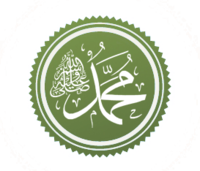Pandangan Kristian pada Zaman Pertengahan terhadap Nabi Muhammad
| Sebahagian dari siri mengenai |
| Muhammad |
|---|
 |
| Riwayat hidup
|
| Kerjaya
|
| Mukjizat
|
| Perspektif
|
| Berkaitan |
|
|
Berbeza dengan pandangan Nabi Muhammad dalam Islam, pandangan Kristian terhadapnya kekal sangat negatif semasa Zaman Pertengahan selama lebih satu milenium.[1][2][3] Pada masa ini, Kristian sebahagian besarnya melihat Islam sebagai bidaah Kristian dan Muhammad sebagai nabi palsu.[4][5][6][7]
Rujukan
Petikan
- ^ "Muhammad." Encyclopædia Britannica. 2007. Encyclopædia Britannica Online. 10 January 2007, eb.com article.
- ^ Esposito, John (1998). Islam: The Straight Path. Oxford University Press. ISBN 0-19-511233-4. p.14
- ^ Watt, W. Montgomery (1974). Muhammad: Prophet and Statesman. Oxford University Press. ISBN 0-19-881078-4. New Edition, p.231
- ^ Bosworth, penyunting (2012) [1993]. "Muḥammad". Encyclopaedia of Islam, Second Edition. 7. Leiden: Brill Publishers. m/s. 360–376. doi:10.1163/1573-3912_islam_COM_0780. ISBN 978-90-04-16121-4.
- ^ Quinn, Frederick (2008). "The Prophet as Antichrist and Arab Lucifer (Early Times to 1600)". The Sum of All Heresies: The Image of Islam in Western Thought. New York: Oxford University Press. m/s. 17–54. ISBN 978-0195325638.
- ^ Goddard, Hugh (2000). "The First Age of Christian-Muslim Interaction (c. 830/215)". A History of Christian-Muslim Relations. Edinburgh: Edinburgh University Press. m/s. 34–49. ISBN 978-1-56663-340-6.
- ^ Hartmann, Heiko (2013). "Wolfram's Islam: The Beliefs of the Muslim Pagans in Parzival and Willehalm". Dalam Classen, Albrecht (penyunting). East Meets West in the Middle Ages and Early Modern Times: Transcultural Experiences in the Premodern World. Fundamentals of Medieval and Early Modern Culture. 14. Berlin and Boston: De Gruyter. m/s. 427–442. doi:10.1515/9783110321517.427. ISBN 9783110328783. ISSN 1864-3396.
Sumber
- Ernst, Carl (2004). Following Muhammad: Rethinking Islam in the Contemporary World. University of North Carolina Press. ISBN 0-8078-5577-4.
- Esposito, John (1998). Islam: The Straight Path. Oxford University Press. ISBN 0-19-511233-4.
- Esposito, John (1999). The Islamic Threat: Myth Or Reality?. Oxford University Press. ISBN 0-19-513076-6.
- Reeves, Minou (2003). Muhammad in Europe: A Thousand Years of Western Myth-Making. NYU Press. ISBN 978-0-8147-7564-6.
- Shalem, Avinoam. Constructing the Image of Muhammad in Europe. Walter de Gruyter, Berlin and Boston, 2013.
- Schimmel, Annemarie (1992). Islam: An Introduction. SUNY Press. ISBN 0-7914-1327-6.
- Schimmel, Annemarie (1995). Mystische Dimensionen des Islam. Insel, Frankfurt. ISBN 3-458-33415-7.
- Tolan, John (2002). Saracens: Islam in the European imagination. Columbia University Press, New York. ISBN 978-0231123334.
- Uebel, Michael (2005). Ecstatic Transformation: On the Uses of Alterity in the Middle Ages. Palgrave, New York. ISBN 978-1403965240.
- Watt, W. Montgomery (1961). Muhammad: Prophet and Statesman. Oxford University Press. ISBN 0-19-881078-4.
- Watt, W. Montgomery (1974). Muhammad: Prophet and Statesman. Oxford University Press. ISBN 0-19-881078-4. New Edition.
- William Montgomery Watt, Muslim-Christian Encounters. Perceptions and Misperceptions
- Irving, W. (1868). Mahomet and his successors. New York: Putnam
Ensiklopedia








